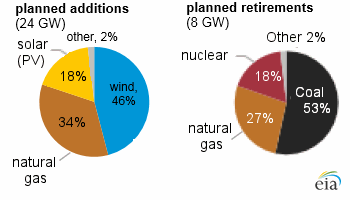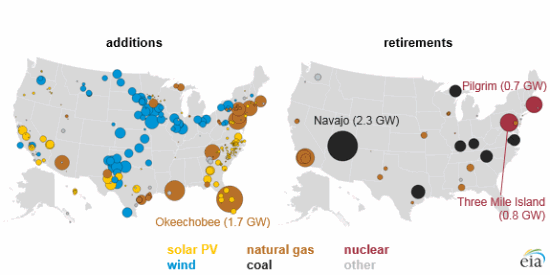Renewables Will Gain Ground in 2019
According to a new report from the U.S. Energy Information Administration (EIA) 2019 will be a good year for renewables. A whopping 46% of new electricity production will come from Wind power and 18% will come from Solar Photovoltaic power with the remaining increase coming from clean burning Natural Gas for a total increase in generating capacity of 24 gigawatts (GW).
On the other hand, 8 gigawatts (GW) of electrical generating capacity will be retired this year 53% of that will be coal fired, 27% natural gas and 18% will be nuclear powered plants.
Electricity Production Capacity Changes in 2019
At first glance it may appear that the 18% Solar (photovoltaic) power will simply replace the 18% nuclear power and the wind will almost replace the coal and the new natural gas plants will a little more than replace the old natural gas plants. But that isn’t true because the planned additions are 3 times larger than the planned retirements. So 18% of 24 GW means that there will be 4.3 GW of new solar production capacity and a loss of 1.4 GW of nuclear capacity (8GW x .18 = 1.44). So actually roughly three times more solar capacity is being added than nuclear is being removed.
According to the eia:
- Solar photovoltaics (+4.3 GW) Nearly half of the 4.3 GW of utility-scale electric power sector solar photovoltaic (PV) capacity additions are located in three states: Texas, California, and North Carolina.
- Nuclear (-1.5 GW) Two nuclear plants totaling 1.5 GW are currently scheduled to retire in 2019. The Pilgrim Nuclear Power Station, located in Massachusetts, is scheduled to retire in May, and the remaining unit at the Three Mile Island Power Station, located in Pennsylvania, is scheduled to retire in September.
- Wind (+10.9 GW) A total of 10.9 GW of wind capacity is currently scheduled to come online in 2019. Most of the capacity will not come online until the end of the year, which is typical for renewable capacity. Three states—Texas, Iowa, and Illinois—will be home to more than half of the 2019 planned wind capacity additions.
- Coal (-4.5 GW). Most of the coal retirements are scheduled to occur at the end of 2019. Half of the planned retirement capacity for coal is at a single plant, Navajo, located in Arizona that first came online in the 1970s. The 4.5 GW of coal-fired capacity expected to retire in 2019 is relatively small compared with the estimated 13.7 GW that retired in 2018, which was the second-highest amount of coal capacity retired in a year.
- Natural gas (+6.1 GW) Planned natural gas capacity additions are primarily in the form of combined-cycle plants (6.1 GW) and combustion-turbine plants (1.4 GW). Most of the natural gas capacity is scheduled to be online by June 2019 in preparation for high summer demand. Of the planned natural gas capacity additions, 60% will occur in Pennsylvania, Florida, and Louisiana.
- Natural gas (-2.2 GW) The scheduled natural gas retirements (2.2 GW) consist mostly (2.0 GW) of steam turbine plants. The natural gas steam turbine plants that are scheduled to retire are all older units that came online in the 1950s or 1960s. Most of the retiring natural gas steam turbine capacity (1.6 GW) is located in California.
- Black = added capacity Red= retired capacity
The above numbers only include electric capacity in the electric power sector. It doesn’t include any production capacity built by other sectors, such as residential rooftop systems and commercial building who also install solar PV. In addition to utility-scale capacity, EIA’s Short-Term Energy Outlook expects an additional 3.9 GW of small-scale solar PV capacity to enter service by the end of 2019. So it is interesting to note that small scale solar capacity will add almost the same amount of solar capacity as the utilities added.
U.S. Electric Capacity Additions and Retirements in 2019 (in Gigawatts)
From the above maps we can see that the majority of the retirements are large scale power plants including a portion of the infamous Three Mile Island nuclear plant in Pennsylvania and the Pilgrim Nuclear plant in Cape Cod and the massive coal fired Navajo generating station. On the other hand, the majority of the additions are smaller scale solar and wind projects but the natural gas plants are larger, with the largest being the Florida Power 1.7 GW Okeechobee Plant.
You might also like:



